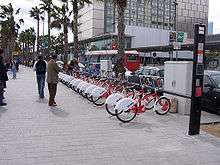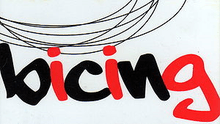Bicing
Bicing is a bicycle sharing system in Barcelona inaugurated on March 22, 2007. It is similar to the Vélo'v service in Lyon or Vélib' in Paris, and using the same bicycles and stations as used in Stockholm, Oslo, and Zaragoza. Its purpose is to cover the small and medium daily routes within the city in a climate-friendly way, eliminating the pollution, roadway noise, and traffic congestion that motor vehicles create..
 | |
 Bicing station and bikes in Barcelona. | |
| Overview | |
|---|---|
| Owner | Ajuntament de Barcelona (municipality) |
| Locale | Barcelona |
| Transit type | Bicycle sharing system |
| Number of stations | 420 (2014)[1] |
| Daily ridership | 28,093 (2014)[1] |
| Annual ridership | 10,113,500 (until October 2014)[1] |
| Website | www.bicing.cat |
| Operation | |
| Began operation | March 22, 2007 |
| Operator(s) | Clear Channel |
| Number of vehicles | 6,000[1] |
Operation
The city council and Clear Channel manage and maintain the system. To use it, users must acquire a yearly membership. Currently the network consists of more than 420 stations to lend and return over 6000 bicycles distributed throughout the system.[1] The stations are situated through most of the flat areas of the city with a distance of around 300 to 400 metres between each one, with many situated next to public transport stops to allow for intermodal use. Metro Stations usually have signs pointing to the locations of nearest Bicing stations. The bikes can be lent from, and returned to, any station in the system, making it suitable for one-way travel. Each station has between 15 and 30 parking slots to fix and lock bicycles, but in highly transited areas many stations may be close together.

To rent a bike one simply swipes the contactless RFID card at a service station to be personally identified by the system, which then unlocks a bike from the support frame. Bicycles can be used for the first 30 minutes with no extra cost, with subsequent half-hour blocks (up to 2 hours) costing 0.70 € each. Use of a bicycle for more than 2 hours at a time is discouraged with a penalty rate of 4.20 € per hour, but also with the possibility of having membership cancelled after a certain number of uses in excess of two hours. To return a bicycle one simply places the bike in a spare slot at a Bicing station; the bike is recognised automatically and is locked into place.
Specialised vans are used to redistribute Bicing bicycles between the stations to even out usage patterns. However, as of November 2007, the number and frequency of vans is not able to keep up during the peak hours, making it very difficult to find a spot at which to return the bike in some areas.
Subscription
Use of the system is based on membership, and users can subscribe online or by visiting a service office. The Bicing member cards are only sent to addresses in Catalonia in an attempt to prevent tourists from using the system.[2] This limitation was imposed upon the City Council by pre-existing local bike hire companies (grouped under Bicitours) that feared what they called illicit competition from the Bicing system. Bicitours and City Council agreed as well in enforcing a user block of ten minutes to change bikes (that is, when docking a bike, the user is blocked for ten minutes before being able to leave with another bike). As a result, tourists are barred from using what is officially denominated a "public transport system".
Bicycle design
The bike is specially designed to prevent theft of parts, or of the whole bike, as well as to prevent vandalism. It is also designed to be easily recognised. However, common user complaints include missing ringbells, cut brakes, and poor maintenance. Bikes have sometimes been stolen, even by sawing the anchors that fix bikes on the stands, and found repainted.
Stations
Bike stations have generally replaced on-street car or motorcycle parking spaces, though others were placed on large pedestrian areas. Each station includes a long series of docks for bikes, with a computerized pylon at one end for completing transactions.
Financing
The system is paid for mostly by local car drivers with an on-street parking control system, distributed throughout much of the densely populated inner city. This money, about €2.23 million annually, is paid to the system operator. The yearly user fee is €47.16 with tax included, which makes it the city's cheapest public transport service.[3] Recently the city made a sponsorship agreement with mobile operator Vodafone to feature the operator's logo on the system in exchange for €1.2 million a year.[4]
Usage statistics
Each individual bike is used between 10 and 15 times a day by different people. More than 95% of rides in the system are shorter than 30 minutes. When a bicycle is returned, a user must wait 10 minutes before taking another one. Although there were over 90,000 registered users in September 2007 only one third of them were using the system on a regular basis. As of November 2007 the system had been used more than 2,750,000 times, representing 8,000,000 km of travel.
Planned future expansion
The bike sharing system was received by the inhabitants with great enthusiasm, covering approximately 70% of the city area, including Ciutat Vella, the Eixample and some parts of Sant Martí and Gràcia. However, stations have not been placed in areas where the grade is greater than four percent, such as the hilly areas of Montjuïc and Tibidabo. Several neighboring cities have asked for the service to be extended to their cities as well, and studies are underway on how to implement this for the wider metropolitan area.[5]
In 2019 the network started a large 7,000 bike expansion with pedal assisted bikes from Canadian firm PBSC [6]
Name
The name is derived from bici, the Catalan and Spanish short-form for bicycle, and BCN, Barcelona's airport code and a popular abbreviation of its name. The English suffix -ing was also added, like the Spanish words footing (a pseudo-anglicism used for jogging), parking (car park), camping (campsite) and Vueling, which is a Catalan airline.
Sources
- "Bicing information about the system". Bicing. Archived from the original on 29 March 2015. Retrieved 5 November 2014.
- Catalunya, El Periódico de. "El Periódico - Actualidad y noticias de última hora". Retrieved 22 February 2017.
- "the weekly ticket is not offered anymore for the above mentioned legal reasons". Archived from the original on 2011-02-21. Retrieved 2011-01-31.
- "Archived copy" (PDF). Archived from the original (PDF) on 2014-07-02. Retrieved 2014-09-16.CS1 maint: archived copy as title (link)
- 20Minutos. "El Bicing unirà les ciutats de l'àrea metropolitana - 20minutos.es". Retrieved 22 February 2017.
- PBSC Urban Solutions https://www.pbsc.com/2018/09/say-hello-to-barcelona/. Retrieved 16 September 2019. Missing or empty
|title=(help)
External links

- Interview with users and city council planner